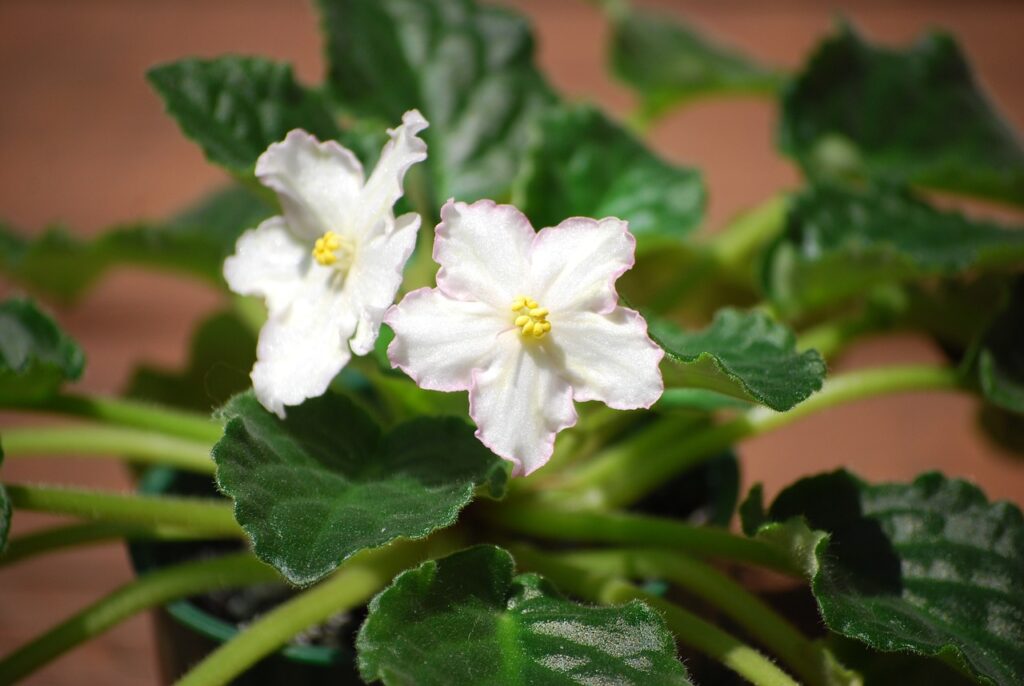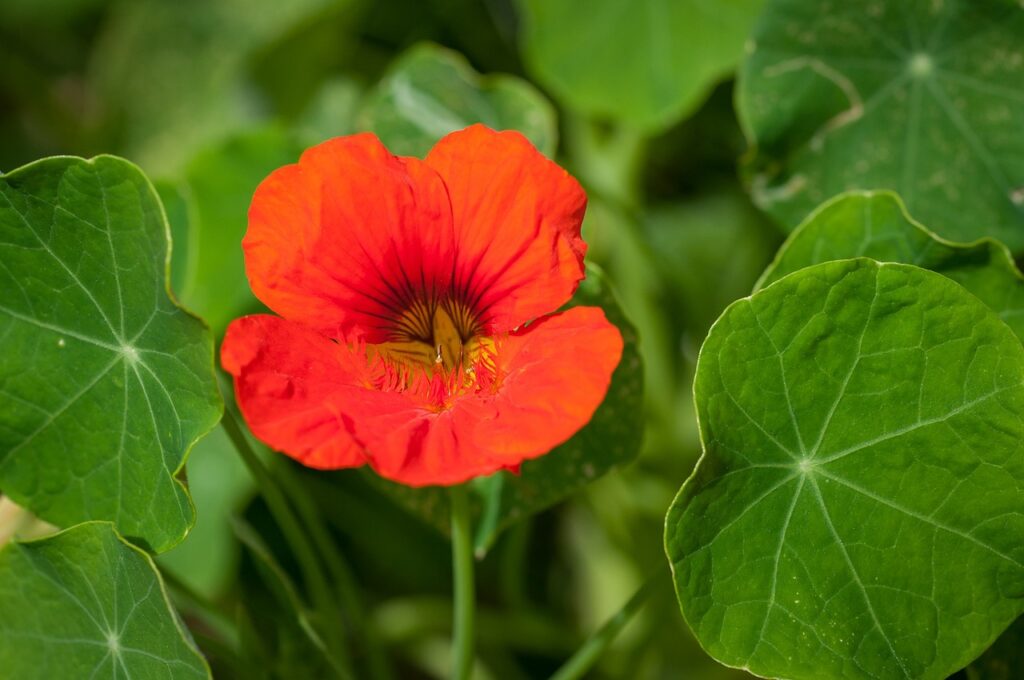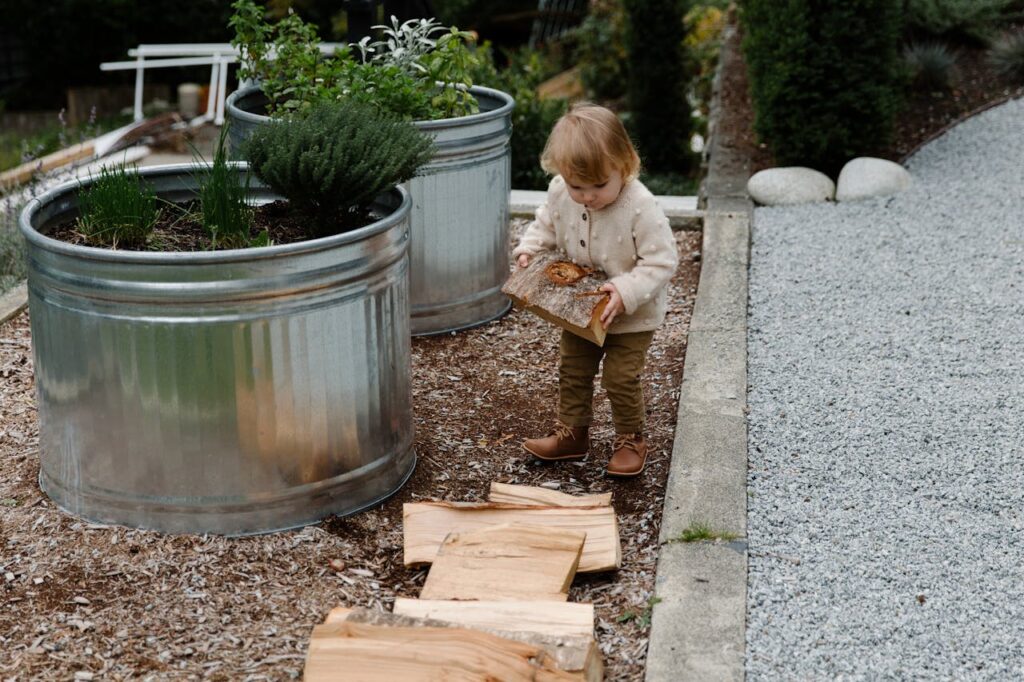If you are passionate about gardening, you will take any opportunity to add something different to your collection. Indoor plants and flowers offer the chance to have your collection on display, no matter what the weather and African violets are an excellent choice. These beautiful, interesting, delicate and versatile plants are a favorite among many green-fingered enthusiasts due to their vibrant colors and easy-to-care-for nature. However, owning African violets does require some effort and thought, and for you to take good care of them. Selecting the right type of pot is a very good starting point, without a good pot, failure is that much closer. In this blog, we will guide you with what you need to know about pots for African violets.

As an Amazon and ebay Affiliate we may earn a commission off any purchases made through our links. This won’t affect the price you pay.
What Are African Violets?
Before we dive into the pots, let’s first identify what African violets are. Also known as Saintpaulia, African violets are native to East Africa and come in various colors. These small plants thrive when placed in bright and indirect sunlight for about six hours a day.
Watering African Violets
Watering African violets, like many others, is a vital aspect of ensuring they stay healthy, grow and thrive. Do not water without checking though, providing too much or too little water can spell trouble for the plant. So, how do you water African violets correctly?
The Basics of Watering African Violets
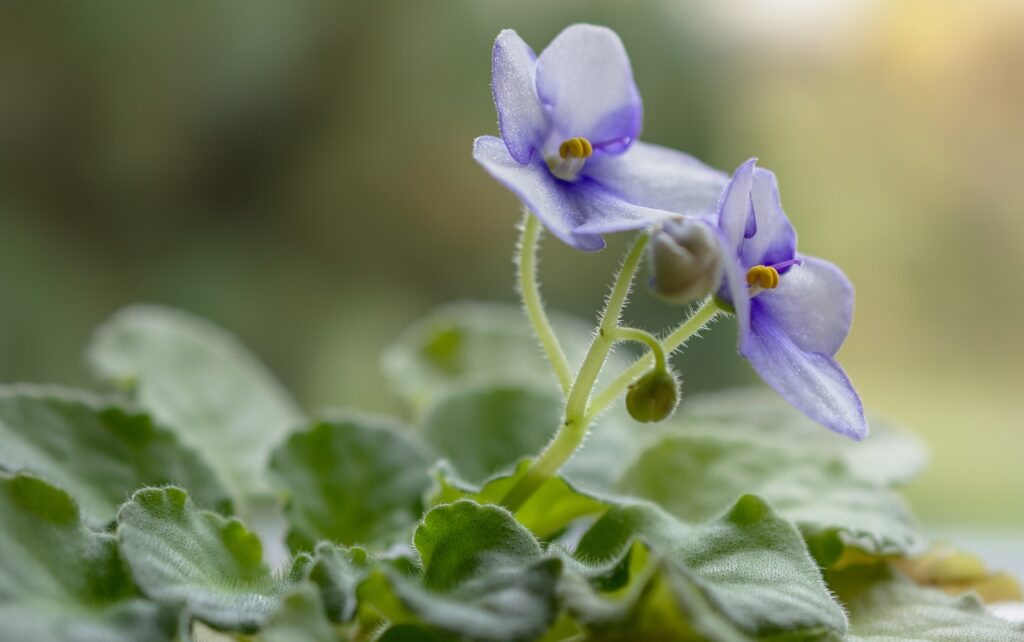
African violets have fine, delicate roots that need consistent moisture levels to remain healthy. However, overwatering can be as dangerous as underwatering and can lead to root rot. Not enough water can cause the plant to droop, wilt and die. Follow a few basic guidelines to ensure you deliver water correctly, to your African Violets:
1. Watering Frequency
African violets need regular watering, but the time between watering sessions depends on several environmental factors such as humidity, temperature, and location. As a rule of thumb, you should water them when the top layer of soil feels slightly dry to touch. This may vary in frequency from once or twice per week to once every two weeks. It all depends on their immediate environment.
2. Watering Technique
Whilst watering African violets, it’s essential to avoid getting water on the leaves(this is true of many plant specimens) because it can lead to spotting or fungal infections. Water the soil directly at the base of the plant, underneath the leaves, making sure to moisten the entire soil surface. Another benefit of base watering is that it avoids getting water on the leaves. Water on the leaves will humidify the air, immediately around the plant. This humidity is an ideal environment for pests such as spider mites.
3. Allow Water to Drain
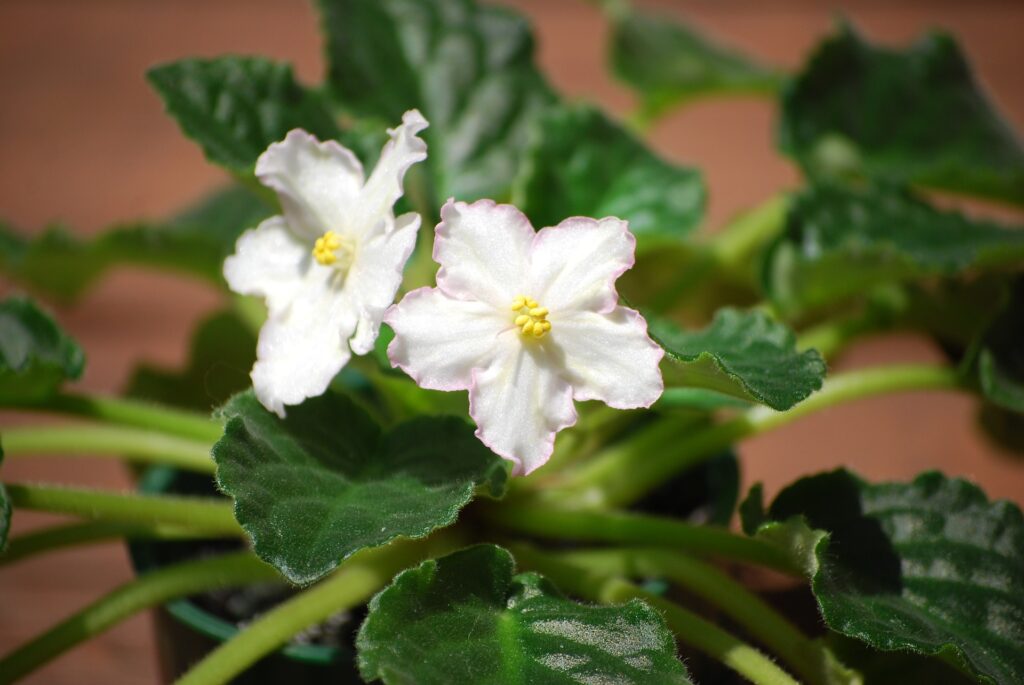
African violets require well-draining soil. Soil that drains well prevents moisture buildup that may lead to root rot. When watering, always allow the excess water to drain away from the pot, ensuring that the soil layer does not become waterlogged. Watering in a sink or basin works for me.
4. Temperature of Water
Use room-temperature water when watering African violets. Water that is an extreme temperature i.e. too cold or too hot, can shock African violets and lead to damage.
Additional Tips for Watering African Violets
- Hard water, that has high mineral content, should be avoided as it can damage the leaves and roots of African violets.
- A handy option is a self-watering pot. These have an inner well that provides an adequate supply of water.
- In very low humidity environments, you can place a shallow dish filled with pebbles and water near the plant.
Why the Right Pot is Important for African Violets
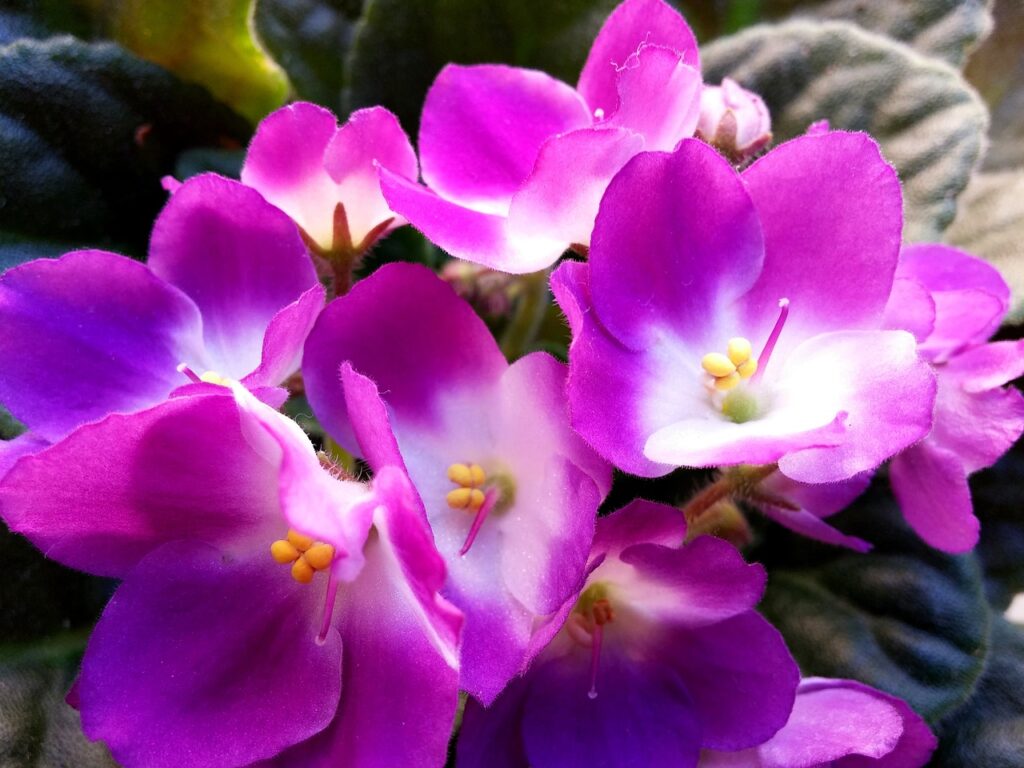
Choosing the right pot for your African violets not only enhances the visual appeal of your home or garden but also ensures that they remain healthy. As mentioned above, African violets have delicate root systems that need plenty of oxygen and moisture. Pots that are too small or too large can lead to various problems such as root rot and poor growth. It’s not worth getting it wrong and it’s certainly not a case of any old flower pot will do.
Why Bother Choosing the Right Pot for African Violets?
- Better drainage: African violets require well-draining soil to thrive. A pot with sufficient drainage holes allows water to flow out and prevent the plants from having ‘wet feet’. This may lead to root rot.
- More air circulation: Airflow around the roots of an African violet ensures no water can build up and that the roots remain healthy and free from rot and fungus.
- Improved growth: The correct size of pot promotes adequate root and plant growth. This will result in a healthy plant with thriving blossoms.
Types of Pots for African Violets
African violets can adapt easily to a variety of pots, but there are a few things to consider when selecting one that is best suited for the plant’s needs. Below is our list of some of the most popular types of pots for African violets.
- Porcelain / Ceramic Pots
Ceramic and porcelain pots are quite a popular option for African violets as they come in a wide range of colors and designs. These types of pots are non-porous and durable, which means they shouldn’t need to be replaced often. Ceramic and porcelain pots need to be watered more frequently because they don’t provide insulation to the soil and plant, compared to plastic pots.

2. Plastic Pots
Plastic pots are tough, lightweight, easy to clean and come in an endless array of sizes and colors. These types of pots are affordable and perfect for small spaces. Plastic pots are practical and durable. They provide a cushioning effect which insulates the soil from temperature fluctuations that would otherwise damage the roots of the African violet plant.
3. Self-watering Pots
Self-watering pots are convenient as they feature an inner reservoir that holds water and distributes it gradually to the soil over time. These types of pots are perfect for people who might forget to water their plants regularly or who are going away for short periods. African violets tend to grow well in these types of pots because of the consistent supply of moisture to the soil.
4. Clay Pots
Clay pots are porous and they also provide good insulation to the soil. These types of pots absorb moisture which is gradually released to the soil. This creates an ideal growing environment for African violets. Clay pots are perfect for those who seek to maintain the right amount of moisture for their plants without watering too frequently. It’s a great use for hobby pottery.
Choosing the Ideal Size of Pot for African Violets
Choosing the right size pot for African violets, will ultimately determine, their overall health and growth. Pots that are too small can lead to overcrowding, bound roots, stunted growth, and sub-par flowering, while pots that are too large can lead to overwatering, root rot, and fungal growth. Here are some tips for determining the right size pot for African violets:
1. Consider the Plant’s Size
The first step in determining the right size pot, is to be mindful of the plant’s current size. The pot size should be adequate to accommodate the plant’s size. This will ensure that the plant gets enough space to grow and maintain healthy roots.
2. Measure the Diameter of the Plant
Once you’ve considered the plant’s size, measure the diameter of the plant at its widest point. The pot should be about one-third to one-half the size of the plant’s diameter. If your plant is six inches in diameter, a pot with a diameter of two to three inches would be appropriate.
3. Determine the Desired Growth
Be clear on the required growth of the African violet before selecting your pot size. If your goal is to keep the plant at its current size, use a pot that matches the plant’s current size. If the desired growth is to promote root growth, use a small pot that is about the same size as the plant’s root ball.
4. Avoid Large Pots
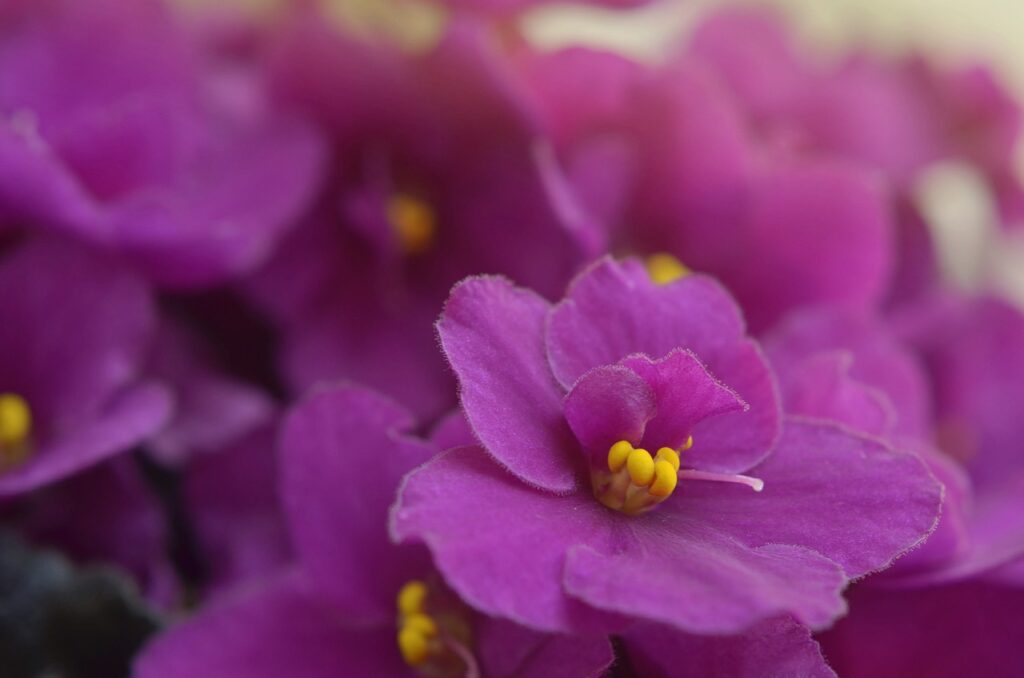
Avoid using pots that are oversized in proportion, to the plant. This can lead to overwatering and subsequently, fungal growth. Pots that are too large also allow the soil to drain and dry too quickly, which can lead to underwatering and stunted growth. This can be tempting, especially if you have a large African Violet plant, but don’t fall into the trap.
5. Consider the Root System
Finally, consider the African violet‘s root system before selecting the pot size. If the root system is small, use a pot that is proportionate to the size of the root system. If the root system is large and established, use a pot that is slightly larger than the root system, about one inch wider in diameter is a good rule to follow.
How to Repot African Violets
African violets need to be repotted every 12 to 18 months. This is because the nutrients from the soil are depleted, and the plant has outgrown the current pot. Here’s how to master African Violet potting:
1. Water the Plant: It’s important to water the plant at least one day before you transplant it. This helps to keep the roots hydrated and plump.
2. Prepare the New Pot: Fill the new pot with fresh soil and make a hole in the center. Use the soil mixture that is ideal for African violets, which should be well-draining and rich in nutrients.
3. Remove the Plant: Carefully remove the plant from the old pot and loosen the root ball. Cut any old or dead roots and gently remove any soil around them.
4. Repot the Plant: Place the African violet plant in the new pot and fill around the root ball with the new soil mixture. Ensure that the soil is firm and that the plant is well-supported.
5. Water the Plant: Gently water the plant after repotting it and place it in a well-lit area.
Feeding African Violets
Once you have successfully potted your plant, it’s time to head to the shop (if you haven’t already) to make sure you have the correct feed to keep it growing well. Get a specific fertilizer for African Violets, it’s worth paying a higher price.
1. Use a High-Quality Potting Mix
African violets require well-draining soil that is rich in nutrients, and using a high-quality potting mix provides an ideal growing environment. A good mix should include peat moss, vermiculite, perlite, and other organic materials. The mixture should be light and airy and allow for proper drainage. The right potting mix is vital because African violets have sensitive root systems that require good drainage to prevent rot.

2. Use the Right Fertilizer
African violets require a balanced, complete fertilizer to promote healthy growth and flowering. The three essential nutrients for African violets are nitrogen, phosphorus, and potassium. Commercial fertilizers that are specially formulated for African violets are widely available in most garden centers. It’s important to choose a fertilizer that is suited for the plant’s current growth stage, whether it’s for vegetative or flowering growth. Avoid overfertilizing the plant as this can lead to fertilizer burn and leaf damage.
3. Apply Fertilizer Correctly
When applying fertilizer, it’s important to use the recommended amount for the plant’s size and stage of growth. Follow the manufacturer’s instructions and dilute the fertilizer with water before use. It’s also a good practice to apply the fertilizer to moist soil to prevent fertilizer burn. Apply fertilizer once every two to three weeks during the growing season, and reduce application during winter when the plant is dormant.
African violet pots must have proper drainage. They must also insulate the soil, and promote healthy growth. Ceramic, porcelain, plastic, clay, and self-watering pots are popular options for growing African violets. Choosing the right size of pot is essential for the plant’s success. Repotting African violets is necessary every 12 to 18 months. Through careful selection of a suitable pot, African violets can provide year-round enjoyment and beauty in your home or garden.
As an Amazon and ebay Affiliate we may earn a commission off any purchases made through our links. This won’t affect the price you pay.
